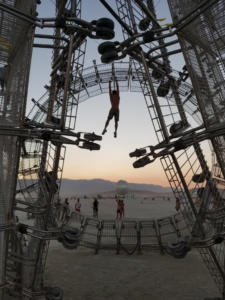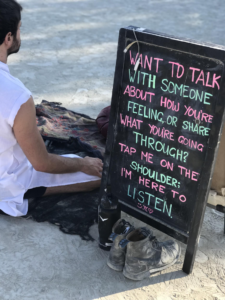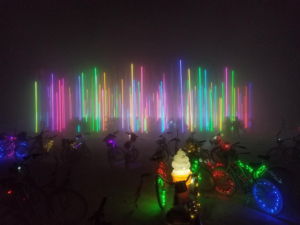Six Things that Burning Man has to Teach Museum Education
“Once a year, tens of thousands of people gather in Nevada’s Black Rock Desert to create Black Rock City, a temporary metropolis dedicated to community, art, self-expression, and self-reliance. In this crucible of creativity, all are welcome.”
– https://burningman.org/event/

There are countless ways people have described their experiences of Burning Man, a week-long gathering of 70,000+ people from all over the world. In 2018, we both participated in the event, and as museum educators we found ourselves asking how we could bring some of it back with us. We also asked how its lessons, which resonated across the spaces and experiences we each design at work, could be applied to immersive and participatory learning. While fully acknowledging the unique context that makes the experience of art there possible, we decided to consider what Burning Man might have to teach museums about connecting people and art.
Thing #1: No Spectators
Art at Burning Man is truly contemporary. It is central to interactions with others there, and in many cases is generated by those very interactions. At every turn people were actively participating in the co-creation of art, often alongside artists. Sculptures are usually climbable, changeable, and interactive–they beckon us to move around and through them together. Happenings pop up unexpectedly and immediately involve anyone who wishes to jump in: One evening at sunset we came across a full orchestra playing Beethoven’s ‘Ode to Joy’ in a dusty plaza; the musicians were handing out kazoos to passers-by so that anyone could join in. By the time we reached the piece’s moving climax, there were several hundred of us. How might museums spark active, spontaneous participation alongside their visitors?
Thing #2: Asking: ‘What if?’
In the grueling heat of the Black Rock City desert, the question of where you can comfortably take shelter takes on new urgency. On the playa (the nickname for the dried lakebed upon which Black Rock City sits), the familiar architecture of bricks and mortar and straight lines gives way to a whole new kind of geometry and construction planning. From tents, domes, pods and yurts to vehicular transformations, all 70,000 of us share the same quandary: what we will live in? Our responses generate a new language around the design of living spaces and of the possibility of creativity within constraint. We become builders and inventors and physically put our stake in the scenery. We also get to see how others approach the same puzzle. And, because there is no “right way” to live on the playa, the result is even more curiosity around possibility and the potential of ideation.

Thing #3: Radical Inclusion
Everyone belongs, and every program, event, or happening makes room for every possible participant. We’re all invited. More than invited, really, because the best examples of radical inclusion went beyond merely inviting everyone to participate–they created clear visual “landing pads” that made it immediately clear how anyone who was interested could get involved. How might museum’s reconsider their ‘landing pads’ for participatory activities?
Thing #4: Be Present
With endless options happening around you, you need to decide where you want to be and embrace your choice, as well as your choice to head somewhere else when you are ready. There is a time in the day for everything you decide to make time for. And because anything is possible on the playa, you constantly need to ask yourself where you want to be, what are your boundaries, and what your wishes are. We were surprised how our answers changed throughout the week and how much we gained from strangers asking me those questions and being present. There is the person offering to share knowledge or skills. There is the person calling out with gifts and encouragement. And, there is the person ready to listen. Each said we have someone to offer. Today, I made time for you. Would you like it?
Thing #5: Transformative Tradition
Ten Principles guide Burning Man. Although we had read the principles many times before arriving (they are the first thing you see on the website, attached to every email, mailed with your ticket etc.), it was only once we got there that we understood their meaning. It was a reminder of how challenging it can be to understand how things work even if you try to make sense of information presented. Upon arrival, it became more clear. As a virgin “burner,” we were instructed to roll on the ground along with all the other newbies. After we covered ourselves in soft playa dust, we each rang a large bell and the community jubilantly cheered, “Welcome Home!” It was a celebration, a homecoming. And our arrival was significant–you felt it–along with the power of tradition, and what a world powered by ten principles could be like: transformative.
Thing #6: Type 2 Fun

Simply put, ‘Type 1 Fun’ is fun while it’s happening, while ‘Type 2 Fun’ is fun that you earn through effort. As a framework for considering participant motivation, this opened up fresh thinking for us about the relationship between informal learning and enjoyment. Burning Man is definitely Type 2 Fun; we worked tremendously hard throughout the experience, and that work pushed us both physically and mentally. We biked for hours in punishing daytime heat and biting nighttime cold in order to explore artworks scattered across the desert. This challenge was embedded in the design of the event, and over time it became profoundly rewarding. In many ways, museums offer visitors a similar Type 2 Fun: visitors are led to believe that the effort of paying attention to specific artworks will be rewarded with the pleasure of understanding. It is interesting to consider how we might continue to make that exertion more intrinsically rewarding on its own.
Concluding Thoughts
Participating in Burning Man reminded us both about what drew us to museum education. In many ways, Burning Man is the ultimate example of an ephemeral and participatory experience. In a short span of time, a world expands and generates more curiosity and wonder than can be described in words. It is made by people for all people to participate. This radical inclusion is enriched by its traditions, an ethos to be present, and a desire to give and to receive from each other. It requires effort–which in and of itself becomes an invitation, an entry point to try something new, to be vulnerable, to question, to play, and to create something together.
David Bowles serves as Education Specialist for Youth Development at the J. Paul Getty Museum and on the Board of Directors for the Museum Education Roundtable.
Miriam Bader serves as Director of Design and Organizational Development at JDC Entwine and as a consultant for cultural and educational institutions.

